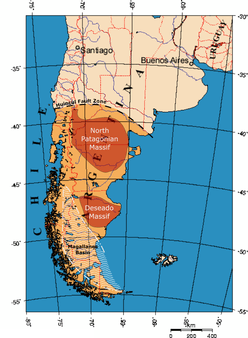Chon Aike Formation
The Chon Aike Formation is an extensive geological formation, present in the Deseado Massif in north-central Santa Cruz Province, Patagonia, Argentina. It covers an area of approximately 100,000 square kilometres (39,000 sq mi) and consists of rhyolitic volcanic rocks, particularly ignimbrites and lavas, with smaller amounts of agglomerates and tuffs.[1] Within dacitic rocks, plant fossils have been found.[2]
| Chon Aike Formation Stratigraphic range: Mid Jurassic-Berriasian ~170–140 Ma | |
|---|---|
| Type | Geological formation |
| Unit of | Bahía Laura Group |
| Underlies | La Matilde & Pampa Rincón Formations |
| Overlies | Tobífera Formation |
| Area | ~100,000 km2 (39,000 sq mi) |
| Lithology | |
| Primary | Rhyolites, ignimbrites, lavas |
| Other | Agglomerates, tuffs |
| Location | |
| Location | Patagonia |
| Coordinates | 47.7°S 70.3°W |
| Approximate paleocoordinates | 44.6°S 29.5°W |
| Region | Santa Cruz Province |
| Country | |
| Extent | Deseado Massif & Austral Basin |
| Type section | |
| Named for | Cerro Chon Aike |
 Map of the Deseado Massif where the formation outcrops | |
Description
The Chon Aike Formation forms part of the Chon Aike Province, also known as the Tobífera Series, a large igneous province that covers 1,700,000 square kilometres (660,000 sq mi).[3]
The northern part of the formation, Río Pinturas, has been dated to the Late Jurassic (140–160 Ma), while the western and eastern sections have been dated to 162 ± 11 Ma and 168 ± 2 Ma respectively, indicating Middle Jurassic eruptions. Fossil flora, however, suggests a Middle to Late Jurassic age. (See La Matilde Formation.)[4]
During the break-up of Gondwana around 180–165 Ma, the opening of the Weddell Sea lead to extension along the western margin of the South American Plate, resulting in intra-plate volcanism in the Chon Aike area and rifting in the Magallanes Basin.[5] The Chon Aike volcanism was probably related to the subduction of the Pacific Phoenix and Farallon plates.[6]
According to Riley, "Early Jurassic silicic volcanic rocks of the Chon Aike Province (V1: 187-182 Ma) are recognized from many localities in the southern Antarctic Peninsula and northeast Patagonia and are essentially coeval with the extensive Karoo (182 Ma) and Ferrar (183 Ma) large igneous provinces of pre-breakup Gondwana.[7]
See also
References
- Channing, Zamuner & Zúñiga 2007, Regional geological setting, pp. 401–402
- Estancia Bajo Pellegrini at Fossilworks.org
- Sruoga, Rubinstein & Hinterwimmer 2004, Geological setting, pp. 32–33
- Pankhurst et al. 1998, Chon Aike Formation, pp. 118–119
- Franzese et al. 2003, Abstract
- Torsvik et al. 2009, 6.1 Jurassic reconstructions (180 and 150 Ma), p. 1325
- Riley, Teal; Flowerdew, Michael; Pankhurst, Robert; Curtis, Mike; Millar, Ian; Fanning, C. Mark; Whitehouse, Martin (2017). "Early Jurassic magmatism on the Antarctic Peninsula and potential correlation with the Subcordilleran plutonic belt of Patagonia". Journal of the Geological Society. 174: 365–376. Retrieved 17 December 2019.
Bibliography
- Channing, A.; Zamuner, A. B.; Zúñiga, A. (2007). "A new Middle–Late Jurassic flora and hot spring chert deposit from the Deseado Massif, Santa Cruz province, Argentina" (PDF). Geological Magazine. 144 (2): 401–411. doi:10.1017/S0016756807003263. Retrieved 13 August 2017.CS1 maint: ref=harv (link)
- Franzese, J.; Spalletti, L.; Pérez, I. G.; Macdonald, D. (2003). "Tectonic and paleoenvironmental evolution of Mesozoic sedimentary basins along the Andean foothills of Argentina (32°–54°S)" (PDF). Journal of South American Earth Sciences. 16 (1): 81–90. doi:10.1016/S0895-9811(03)00020-8. Retrieved 13 August 2017.CS1 maint: ref=harv (link)
- Pankhurst, R. J.; Leat, P. T.; Sruoga, P.; Rapela, C. W.; Márquez, M.; Storey, B. C.; Riley, T. R. (1998). "The Chon Aike province of Patagonia and related rocks in West Antarctica: A silicic large igneous province" (PDF). Journal of Volcanology and Geothermal Research. 81 (1): 113–136. doi:10.1016/S0377-0273(97)00070-X. Retrieved 13 August 2017.CS1 maint: ref=harv (link)
- Sruoga, P.; Rubinstein, N.; Hinterwimmer, G. (2004). "Porosity and permeability in volcanic rocks: a case study on the Serie Tobı́fera, South Patagonia, Argentina" (PDF). Journal of Volcanology and Geothermal Research. 132 (1): 31–43. doi:10.1016/S0377-0273(03)00419-0. Retrieved 13 August 2017.CS1 maint: ref=harv (link)
- Torsvik, T. H.; Rousse, S.; Labails, C.; Smethurst, M. A. (2009). "A new scheme for the opening of the South Atlantic Ocean and the dissection of an Aptian salt basin". Geophys. J. Int. 177 (3): 1315–1333. doi:10.1111/j.1365-246X.2009.04137.x. Retrieved 13 August 2017.CS1 maint: ref=harv (link)
Further reading
- R. E. Barrio, O.G. Arrondo, A.E. Artabe and B. Petriella. 1982. Estudio geologico y paleontologico de los alrededores de la Estancia Bajo Pellegrini, Provincia de Santa Cruz. Revista del Asociacion Geologica Argentina 37(3):285-299